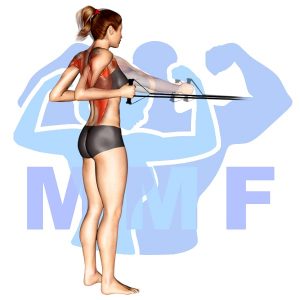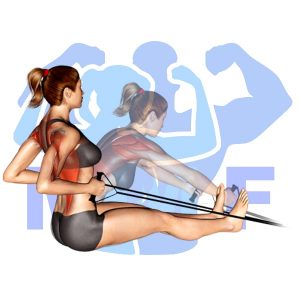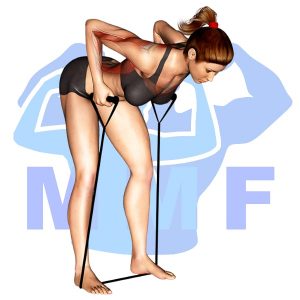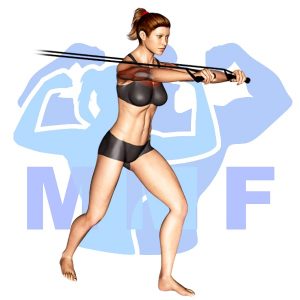Do you struggle with back pain after performing exercises such as the resistance band straight back seated rows? You’re not alone! Many fitness enthusiasts experience discomfort or pain in their back during or after exercise. It’s a common issue that can be caused by poor form or inadequate support during the exercise. However, with the right technique and equipment, you can safely and effectively strengthen your back without exacerbating any existing pain. In this post, we’ll dive into the proper form for resistance band straight back seated rows and how to use these exercises to alleviate back pain and improve overall back strength.
Resistance Band Straight Back Seated Rows Summary
- Primary Muscles: Deltoid – Posterior
- Secondary Muscles: Brachialis, Brachioradialis, Erector Spinae, Infraspinatus, Latissimus Dorsi, Pectoralis Major – Sternal, Rhomboids, Teres Major, Teres Minor, and Trapezius
- Equipment: Resistance Band
- Mechanics Type: Compound
- Force: Pull
- Utility: Basic or Auxiliary

Resistance Band Straight Back Seated Rows Instructions
- Sit on the ground feet extended in front of you. Wrap the middle of the band around your feet until the band is tight when you grab the handles with your legs and back straight making a 90-degree angle.
- Now perform the rows by pulling your arms and bringing your elbows back to your side, and the handles will come close to touching your abs. Additionally, maintain your back straight when you are pulling the bands, these are straight back seat rows.
- Pause and squeeze your back muscle at your full contraction.
- Then, slowly let the bands pull your arms forward into the starting position.
- Repeat these straight back rows for 8-12 reps.
Video Tutorial
Resistance Band Straight Back Seated Rows Muscles
Target (Agonist)
- Deltoid, Posterior
- Erector Spinae
- Infraspinatus
- Latissimus Dorsi
- Rhomboids
- Teres Major
- Teres Minor
- Trapezius
Synergists
- Brachialis
- Brachioradialis
- Pectoralis Major – Sternal
Dynamic Stabilizers
- Biceps Brachii
- Triceps – Long Head
Stabilizers
- Adductor Magnus
- Erector Spinae
- Gluteus Maximus
- Hamstrings
Antagonist Stabilizers

Benefits of Resistance Band Straight Back Seated Rows
The Resistance Band Straight Back Seated Row is an excellent exercise for strengthening the posterior deltoid muscle. This exercise targets the upper back, which helps to improve posture and stability. It also helps to strengthen the shoulder joint and improves shoulder stability, which can reduce the risk of injury. Additionally, this exercise helps to improve core strength and stability, as well as increase overall power. Furthermore, the Resistance Band Straight Back Seated Row also activates the posterior deltoid, allowing for increased range of motion and a more balanced physique. As a result, performing this exercise on a regular basis can help to develop stronger and more defined shoulders.
Tips for Performing Resistance Band Straight Back Seated Rows
If you want to attain the optimum improvement, use these simple tips. Similarly, if you want to avoid injuries, follow these tips.
- Double Up Bands To Increase The Workout. If you find that you can easily perform 12 or more reps every exercise, then you ought to add to the level of resistance. You can either do this by stretching the band extra at the outset of the exercise or by using more bands. The favored technique is to add some more bands due to the fact it is easily repeatable to have a similar resistance on every set.
- Perform The Appropriate Amount Of Sets With Rest. Your objective, to begin with, might be to do 3 sets to near failure. However, you can build up to 5 sets. If your muscle tissue isn’t fatigued at the conclusion of 3 – 5, something ought to change. Initally, you can increase the resistance to make each rep more difficult. Next, you can decrease the rest time in between each set.
Benefits and Tips Video
Frequent Mistakes To Avoid
You must avoid these regular mistakes to ensure ideal form and reaching your goals. At the same time
- Don’t have unmatched resistance on each side, because you will train both sides with an imbalance.
- Don’t relax your core. Flexing your stomach protects your spine by maintaining your internal pressure.
- Don’t use To Little or Too Much Resistance. Not enough, and you will not be adequately fatiguing your agonist (target) muscle, more than the right amount, and you will probably cheat. Make certain you can conduct between 8-12 reps with proper form.
Find More Resistance Band Exercises Here
Variations and Complementary Exercises
For those looking to mix up their exercise routine, there are a few variations, complementary, and alternative exercises that can be done in place of the Resistance Band Straight Back Seated Rows. The following list contains exercises that target the same muscles as the Resistance Band Straight Back Seated Rows:
Resistance Band Standing Rows

Resistance Band Standing Rows are a complementary exercise to Resistance Band Straight Back Seated Rows. They target the same muscles but in a slightly different way. Standing Rows involve standing with feet hip-width apart, holding the band handles at shoulder height with elbows bent and palms facing inwards. Keeping the back straight, pull the band handles toward the chest and return to starting position. This exercise is great for building upper body strength, particularly in the back and shoulders. It is an excellent alternative to Seated Rows, as it allows for more mobility and stability in the core.
Resistance Band Seated Rows

Resistance Band Seated Rows is a great complementary or alternative exercise to Resistance Band Straight Back Seated Rows. This exercise focuses on the back muscles and strengthens them. To do this exercise, sit in a chair with the resistance band looped around your feet and the other end of the band in each hand. Keeping your back straight, pull the band towards you and squeeze your shoulder blades together. Slowly release the band and repeat. This exercise helps to build strength in the upper back, core and arms.
Resistance Band Face Pulls

Resistance band face pulls are a great complementary or alternative exercise to resistance band straight back seated rows. This exercise targets the posterior deltoids, rhomboids, and upper back muscles while also engaging the biceps and core. To perform this exercise, start by anchoring a resistance band to a door or wall at chest height and looping the band around both hands. Keep your elbows high and out to the sides as you pull the band towards your face. Make sure to engage your core throughout the movement and pause at the top of the exercise for a moment before slowly returning to the starting position. Resistance band face pulls are a great way to add variety to your routine and target similar muscles as resistance band straight back seated rows.
Check Out These Top Resistance Band Exercises
Resistance Band Bent Over Shoulder Rows

Resistance Band Bent Over Shoulder Rows are a great complementary exercise to Resistance Band Straight Back Seated Rows. This exercise requires you to bend at the hips, keeping your back flat and your chest up as you use the resistance band to pull your hands up towards your shoulders. This exercise works the same muscles as the Straight Back Seated Row but puts more emphasis on the posterior deltoids and rhomboids, helping to target and strengthen these muscles even further. By combining these two exercises, you can get a great full-body workout that will help improve your overall strength and posture.
Resistance Band Bent Over Rows

Resistance Band Bent Over Rows is a complementary exercise to Resistance Band Straight Back Seated Rows. This exercise helps to strengthen the back, arms, and shoulders, while also engaging the core muscles. It is an effective exercise for targeting the lats and rhomboids, two key muscles used in the Resistance Band Straight Back Seated Rows. Unlike the seated rows, this exercise requires you to be in a bent over position, which will help to better target the muscles in the back. Additionally, because you are standing, you can use your legs to add extra resistance as needed. All of these features make Resistance Band Bent Over Rows an excellent alternative or complementary exercise to Resistance Band Straight Back Seated Rows.
Resistance Band Bent Over Rear Lateral Raises

Resistance Band Bent Over Rear Lateral Raises are a great complement to Resistance Band Straight Back Seated Rows. This exercise targets the rear deltoids, which are often underutilized when training the back. Additionally, it helps to balance out the muscles in the back, improving posture and overall strength. This exercise can also be used as an alternative to Straight Back Seated Rows if the individual is unable to perform the exercise with proper form. Resistance Band Bent Over Rear Lateral Raises can also be used as an isolation exercise to target the rear deltoids and improve their strength and size.
Find More Back Exercises Here
Opposing Complementary Exercises
Complementary exercises can help target opposing muscle groups, making the workout more complete and effective. To strengthen the back muscles, there are a number of exercises that work the opposing muscle groups. Below are some of the most effective exercises to pair with Resistance Band Straight Back Seated Rows:
Resistance Band Chest Press

The Resistance Band Chest Press is a great complement to the Resistance Band Straight Back Seated Rows exercise. This exercise works the opposite muscle group, focusing on the chest and shoulders. The chest press helps to build strength and stability in the upper body while also providing a great source of tension for the opposing muscles used in the seated rows. This combination of exercises will help to create balance in your upper body strength and provide an overall better look.
Resistance Band Push Ups

Resistance Band Push Ups are a great exercise to compliment Resistance Band Straight Back Seated Rows. While the rows target the back muscles, the push ups target the chest and triceps, using opposing muscle groups. This helps to build balance and stability in the body while strengthening the targeted muscles. The resistance bands also add an extra challenge to the push ups, making them more effective in building strength and toning the upper body.
Resistance Band Low Chest Flys

Resistance Band Low Chest Flys and Resistance Band Straight Back Seated Rows are two complementary exercises that target opposing muscle groups. The Low Chest Flys exercise is designed to work the chest muscles, while the Straight Back Seated Rows exercise is designed to work the back muscles. Performing both of these exercises in succession helps to effectively target both muscle groups, while also providing balance to the body. Low Chest Flys allow you to isolate and strengthen your chest muscles, while Straight Back Seated Rows allow you to do the same for your back muscles. Both of these exercises are excellent for improving overall strength and posture, and should be included in any strength training routine.
Sculpt Your Back with Resistance Band Rows
Resistance band rows are a versatile and effective exercise for sculpting a stronger, more defined back. By targeting the upper and middle back muscles, this exercise improves posture, reduces the risk of injury, and enhances overall body composition. With just a band and a sturdy anchor point, you can create a personalized workout anywhere, anytime. Whether you’re a beginner or a seasoned fitness enthusiast, incorporating resistance band rows into your routine can help you achieve your fitness goals.
References: Wikipedia | ExRx.net | PubMed.gov | Comprehensive List of Back Resistance Band Exercises

